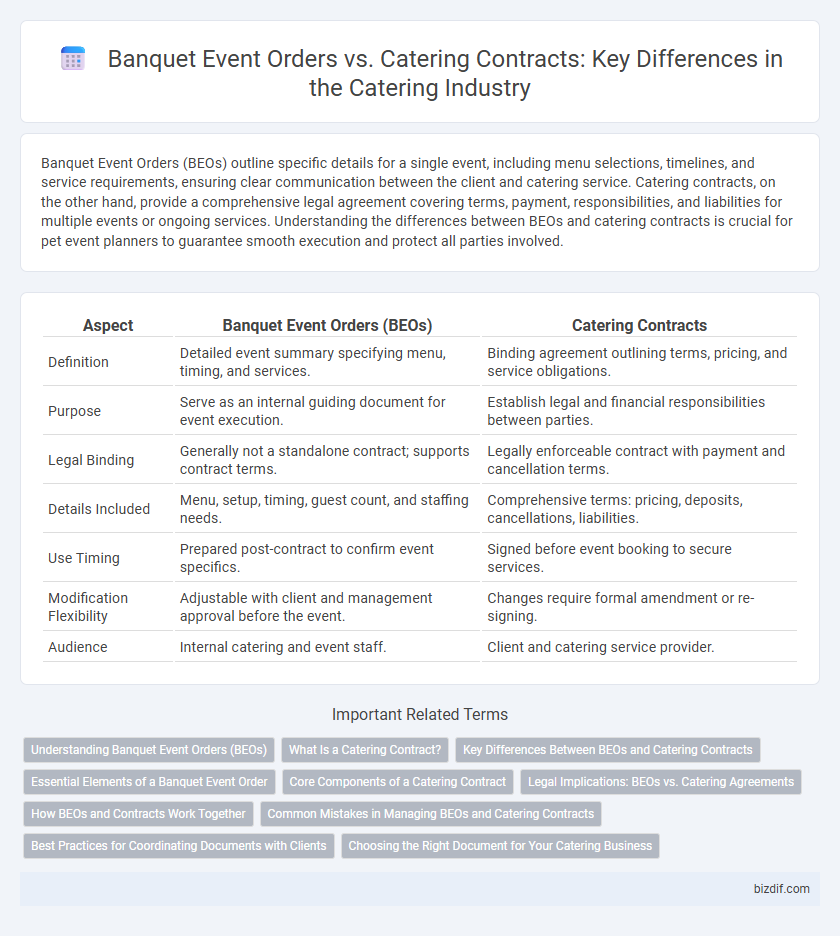Banquet Event Orders (BEOs) outline specific details for a single event, including menu selections, timelines, and service requirements, ensuring clear communication between the client and catering service. Catering contracts, on the other hand, provide a comprehensive legal agreement covering terms, payment, responsibilities, and liabilities for multiple events or ongoing services. Understanding the differences between BEOs and catering contracts is crucial for pet event planners to guarantee smooth execution and protect all parties involved.
Table of Comparison
| Aspect | Banquet Event Orders (BEOs) | Catering Contracts |
|---|---|---|
| Definition | Detailed event summary specifying menu, timing, and services. | Binding agreement outlining terms, pricing, and service obligations. |
| Purpose | Serve as an internal guiding document for event execution. | Establish legal and financial responsibilities between parties. |
| Legal Binding | Generally not a standalone contract; supports contract terms. | Legally enforceable contract with payment and cancellation terms. |
| Details Included | Menu, setup, timing, guest count, and staffing needs. | Comprehensive terms: pricing, deposits, cancellations, liabilities. |
| Use Timing | Prepared post-contract to confirm event specifics. | Signed before event booking to secure services. |
| Modification Flexibility | Adjustable with client and management approval before the event. | Changes require formal amendment or re-signing. |
| Audience | Internal catering and event staff. | Client and catering service provider. |
Understanding Banquet Event Orders (BEOs)
Banquet Event Orders (BEOs) serve as detailed documents outlining every aspect of an event, including menu selections, timing, setup, and service specifications, ensuring seamless communication between clients and catering teams. Unlike catering contracts that establish overall terms and legal obligations, BEOs function as operational blueprints tailored for individual events within the contract's framework. Accurate and thorough BEOs minimize misunderstandings and guarantee that event expectations are met with precision and professionalism.
What Is a Catering Contract?
A catering contract is a legally binding agreement between the client and the catering service provider outlining specific terms such as menu choices, event date, payment details, and cancellation policies. It legally protects both parties by clearly defining responsibilities, deadlines, and deliverables, ensuring expectations are met for the event. Unlike a banquet event order, which serves as a detailed event plan, the catering contract formalizes the business commitment and terms of service.
Key Differences Between BEOs and Catering Contracts
Banquet Event Orders (BEOs) are detailed documents outlining specific event logistics such as menu, timing, and room setup, serving as operational guides for catering staff. Catering contracts are legally binding agreements that define the terms, conditions, payment schedules, cancellations, and responsibilities between the client and the catering provider. The primary difference lies in BEOs focusing on event execution details, while catering contracts govern the overall business relationship and legal obligations.
Essential Elements of a Banquet Event Order
Banquet Event Orders (BEOs) detail essential elements such as menu selections, guest count, event timeline, and room setup, ensuring precise communication between clients and caterers. Unlike catering contracts, which establish overarching legal terms and payment schedules, BEOs serve as operational blueprints for event execution. This specificity guarantees that catering services meet client expectations and logistical requirements seamlessly.
Core Components of a Catering Contract
Catering contracts include essential components such as event details, menu selections, service requirements, payment terms, cancellation policies, and liability clauses to ensure clarity between the caterer and client. Unlike Banquet Event Orders, which serve as operational guides for event execution, catering contracts establish legally binding agreements that protect both parties. Clear articulation of responsibilities and deliverables in the contract minimizes disputes and facilitates seamless event management.
Legal Implications: BEOs vs. Catering Agreements
Banquet Event Orders (BEOs) typically serve as detailed confirmations of event specifics without constituting legally binding contracts, which limits their enforceability in disputes. Catering contracts, in contrast, are formal agreements that clearly outline legal obligations, terms, and conditions, providing stronger protection for both parties in case of breach or liability issues. Understanding the legal implications of using BEOs versus full catering contracts is crucial to minimize risk and ensure compliance with industry regulations.
How BEOs and Contracts Work Together
Banquet Event Orders (BEOs) and catering contracts work together to ensure seamless event execution by outlining specific event details and legally binding terms. While catering contracts establish the overall agreement, payment terms, and cancellation policies, BEOs provide a detailed day-of-event blueprint, including menu selections, staffing, and timelines. This collaboration between BEOs and contracts enables catering companies to coordinate logistics effectively and deliver consistent client experiences.
Common Mistakes in Managing BEOs and Catering Contracts
Confusing Banquet Event Orders (BEOs) with catering contracts often leads to miscommunication and logistical errors in event planning. Common mistakes include failing to update BEOs with last-minute client changes and neglecting to align catering contracts with agreed service terms, resulting in disputes over deliverables and payments. Clear differentiation between the operational details in BEOs and the legal obligations in contracts ensures smoother event execution and client satisfaction.
Best Practices for Coordinating Documents with Clients
Banquet Event Orders (BEOs) and catering contracts serve distinct purposes in event planning; BEOs detail the logistical specifics, while contracts define overall terms and conditions. Best practices for coordinating these documents with clients include ensuring clear communication, confirming all event details in writing, and double-checking for consistency between the contract and BEO to avoid misunderstandings. Maintaining organized records and implementing a standardized system for document revisions helps streamline approvals and enhances client satisfaction.
Choosing the Right Document for Your Catering Business
Banquet Event Orders (BEOs) provide detailed, event-specific instructions and menu details, essential for ensuring seamless communication between catering staff and clients on the day of the event. Catering contracts establish legally binding agreements outlining terms, payment schedules, cancellation policies, and service expectations, offering crucial protection and clarity for both parties. Selecting the appropriate document depends on your business needs: use BEOs for operational precision and catering contracts to secure commitments and manage risks effectively.
Banquet Event Orders vs Catering Contracts Infographic

 bizdif.com
bizdif.com